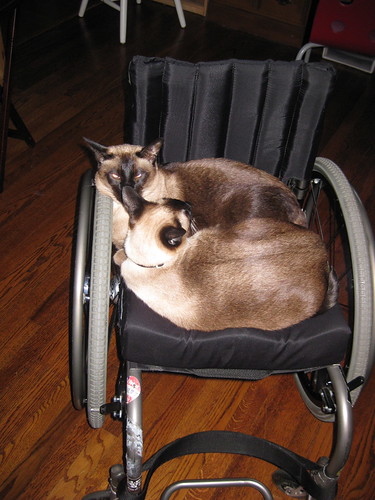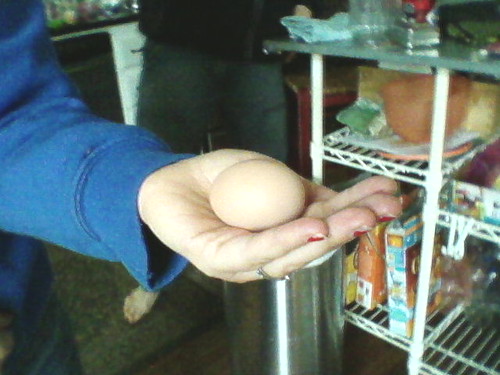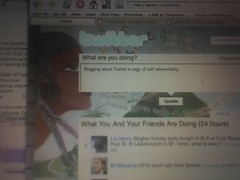I’m getting ready to fly out to Austin for SXSWi, where I’m going to talk at a session on Sunday afternoon, “Fictional Blogging”. Marrit Ingman at the Austin Chronicle interviewed me here: Where the Wild Things Blog. For once, I’m not talking about myself or making anyone’s eyes glaze over with my wild Theories About Twitter:
Liz Henry, who will present the Fictional Bloggers panel with blog-novelist Odin Soli of Plain Layne fame, emphasizes the importance of disclosure. “We want lying we can trust, lying that’s transparent,” she explains. “We don’t want to feel stupid and be tricked by hoaxes. But some lying, the lying of fiction, is good and ethical. It creates distance between a person and the world, and in this distance we can explore crazy, fascinating ideas.”
Henry adds, “If corporations used fictional blogs seamlessly and with artistry, a lot of people wouldn’t mind the fakitude. They’d be entertained. We could potentially love the PSP2 fake bloggers just as we love Chaucer Hath a Blog if the PSP2 blog was any good.”
Instead of being good, the ad company responsible for Sony’s viral campaign, Zipatoni, drew the ire of consumers with the blog’s lack of corporate disclosure, ostensibly teenage pidgin, and blatantly fake “flogging.” (“so we started clowning with sum not-so-subtle hints to j’s parents that a psp would be teh perfect gift,” read the first entry on www.alliwantforxmasisapsp.com/blog, itself shut down last December.)
“Companies who want to build out a fictional character should hire novelists and playwrights, role-playing gamers and LARPers, bloggers and social media people – creative world-builders who understand how to bring life to an online presence. Blog readers and Web-entertainment consumers are sophisticated. They want depth to a character,” Henry says.
Odin is an awesome geek and all-around internetty consultant sort of person as well as a novelist. I like how he includes his old .plan files as part of his web site. I always thought of them as old school blogging… And I wish I still had mine!
I’m working now for Socialtext now, as their open source community manager, but my panel has nothing to do with that and everything to do with my history as a bookish and writerly and bloggity person.
But because I’m being soaked up to my eyebrows in wikis right now, I talked about them with Marrit too, so bear with me while I write that up and quote myself at enormous unquotable length:
I’d love to see companies blog creatively from the points of view of minor characters in a novel or other fictional series. I don’t want Harry Potter’s blog; I want Dobby’s blog or Neville’s or Pansy Parkinson’s. Or better yet, a network of interlinked fictional blogs and worlds. In the imaginary world, we aren’t limited by truth, reality, history, or time. We can have Genghis Khan blogging in dialogue with Caroline Ingalls and Picard and two hundred different Harry Potters, with real people thrown in the mix. A smart company would interlock its fictional worlds and information and allow participation from everyone in the building of alternate fictional realities. There’s a lot of energy in fanfiction, for example. This energy should be welcomed by media owners and publishers, who need radical change in their approach to intellectual property.
Book publishers aren’t getting wikis either – or not enough of them are getting it. Every book needs a wiki. Every book needs a blog, but I’d push it further and say that they need wikis too, or blikis.
Wikis have enormous creative potential. Socialtext uses wikis and blikis to increase collaboration and speed up communication in big corporations. Corporate wikis change the ways people talk with each other at work, or how they approach the definition of a project. But novelists and creative writers need to play with wikis in many other areas. Wikis are clearly useful for worldbuilding in science fiction and fantasy. But let’s push it further. We could write a novel as a wiki. Someone should do that for Nanorimo! Maybe they already have. It’s a scary thought, isn’t it, if you’re a writer? It challenges the idea of authorship, authority, style, and the singular voice of the genius artist. That’s a fine challenge with a ton of potential. When we get our first excellent bestselling novel written by a wiki collective — better yet by an open collective — we’ll know that our society’s approach to the generation of knowledge has evolved. Fans groups of particular wikinovel hive minds will spring up. Literary criticism will change as well, and academia’s resistance to collaboration will have to evolve to change with the times.
Book publishers aren’t getting how to make a blog into a book. What is the value of the book? Besides editing the blog and making it portable, a book should annotate. The book of Riverbend’s blog, for example, could have been a fantastic book rather than just a nicely bound bundle of printouts. Add information, indexes, annotation, glossaries, diagrams, geneologies. Enrich a blog; don’t just print it. Publishers think people don’t want footnotes. They’re wrong. When people love a world, a character, or a subject — or a blog — they want to know everything, on different levels. A generation that grew up listening to DVD commentary tracks and writing complex Wikipedia articles about Pokemon characters does, indeed, love footnotes, and the option for depth of information they provide.
Anyway!
The conference was great last year. It was supposedly the year of everyone marveling at OMG there are girls and brown people here OMG OMG there is a line for the women’s room at a tech conference! Diversity was nice, I think it will continue, and I hope it has positive and tangible results for the “diversity-providers” as well as making everyone else feel all warm and fuzzy. The conference itself benefitted, if you think of their increase in attendees as being correlated with the array of speakers from different backgrounds – and I do think that’s true. I had to laugh a bit at the SXSW magazine that came in the mail last month, and its article on the British Invasion. What a spin. “Last year we had women! This year omg white guys are invading our conference! It’s so radical!” Every cliche was invoked. It was sweet, really! I’m not complaining — British geek guys are super sexy, they dress nicer than American white guys, they don’t make the bathroom lines longer for all the women (that’s important!) and I think they grace any conference with their cute accents and snarky comments and the way they act sort of uptight and then get drunk and let it all hang out. Kind of like Spock. The invasion’s fine with me!
In fact, right after I talked with Marrit about collaboration, world building, and wikis, I had lunch with Paul Youlten from Yellowiki, a very fascinating multi-tentacled person who is now building a collaborative fictional Latin American geographical space, Batán. I did not quiz him too deeply on the imperialist implications of his Bruce-Chatwin-esque wiki thing because I think it’s a fine cultural experiment, and if English-speaking people are going to construct a fake Latin America, they might as well make it overtly fake rather than constructing it on real cities where people actually live. (I realize that only about 3 people will get this or laugh at it, but it’s worth it to make them laugh really hard. This means you, Brian, Prentiss, and Gabby!)
(Meanwhile, as I’m blogging this in a cafe, there’s a guy across from me with a big Daviswiki sticker on his laptop. Wiki Everywhere!)
Back to the conference!
I’m looking forward to seeing some people I don’t see that often – to the rush of intense conversations – to eating breakfast at my favorite breakfast place ever which I shall not name because I don’t want you all to go there and make it too crowded – And to picking up some more Turitella fossils from the limestone bed of Shoal Creek, because I gave all the ones I picked up last year to little kids. And to going to all the wiki panels and open source panels and doing more soaking-stuff-up.
Also notable in my pre-conference rush: I got very excited at getting my cute little MOO cards. I have two kinds – one for my real name stuff and one for the main pseudonymous-me.
Technorati Tags: conversations, literature, collaboration, puppy, sxswi2007, wikis, writing




